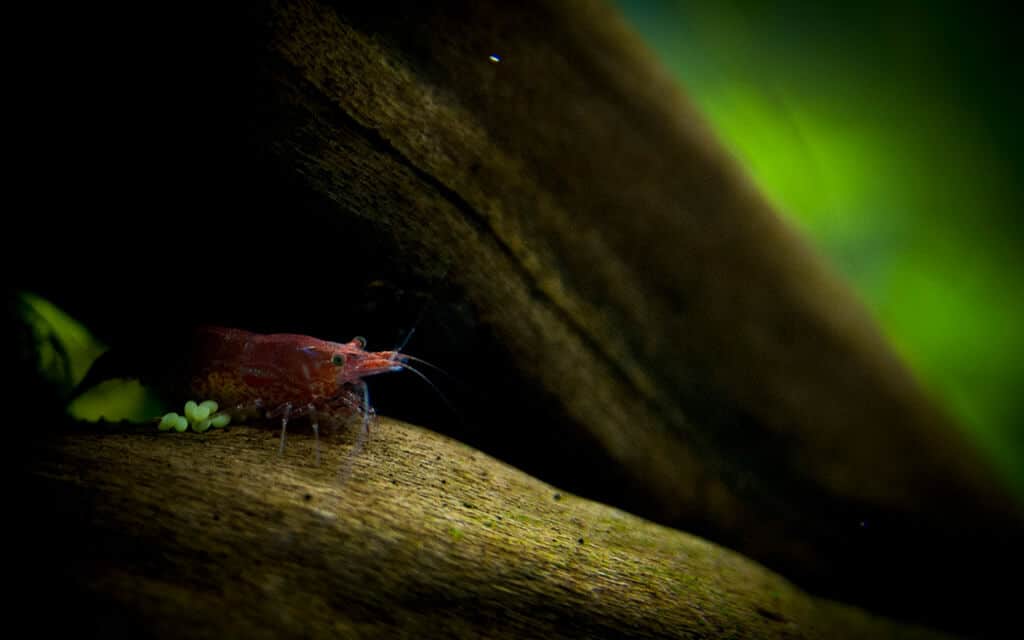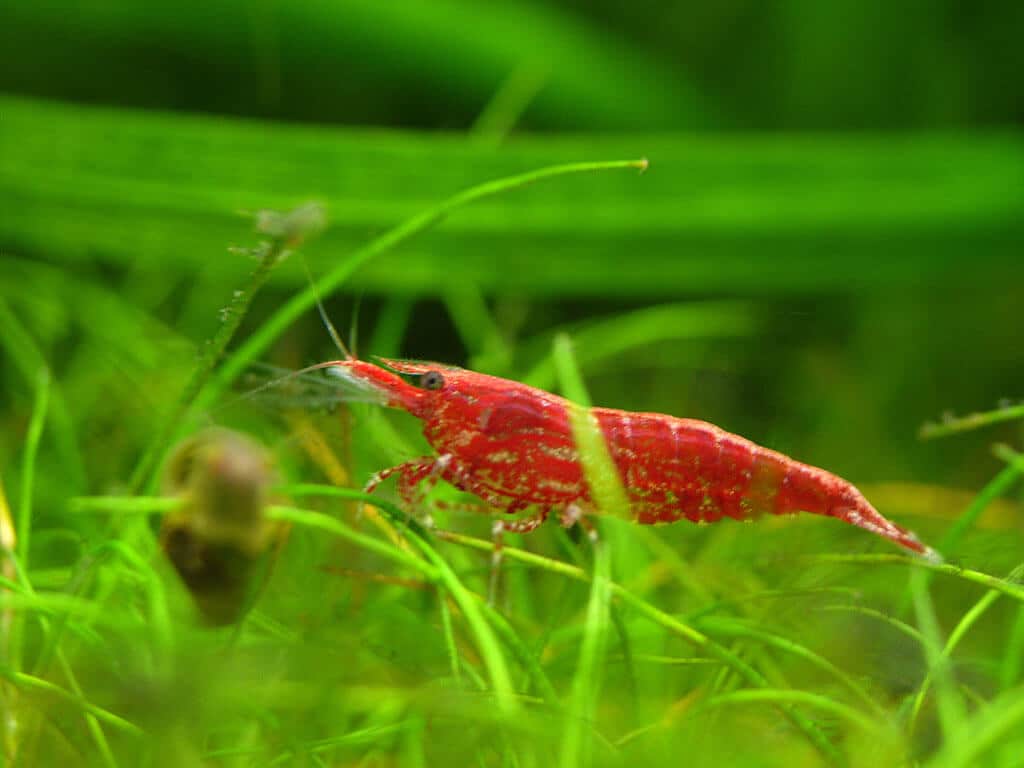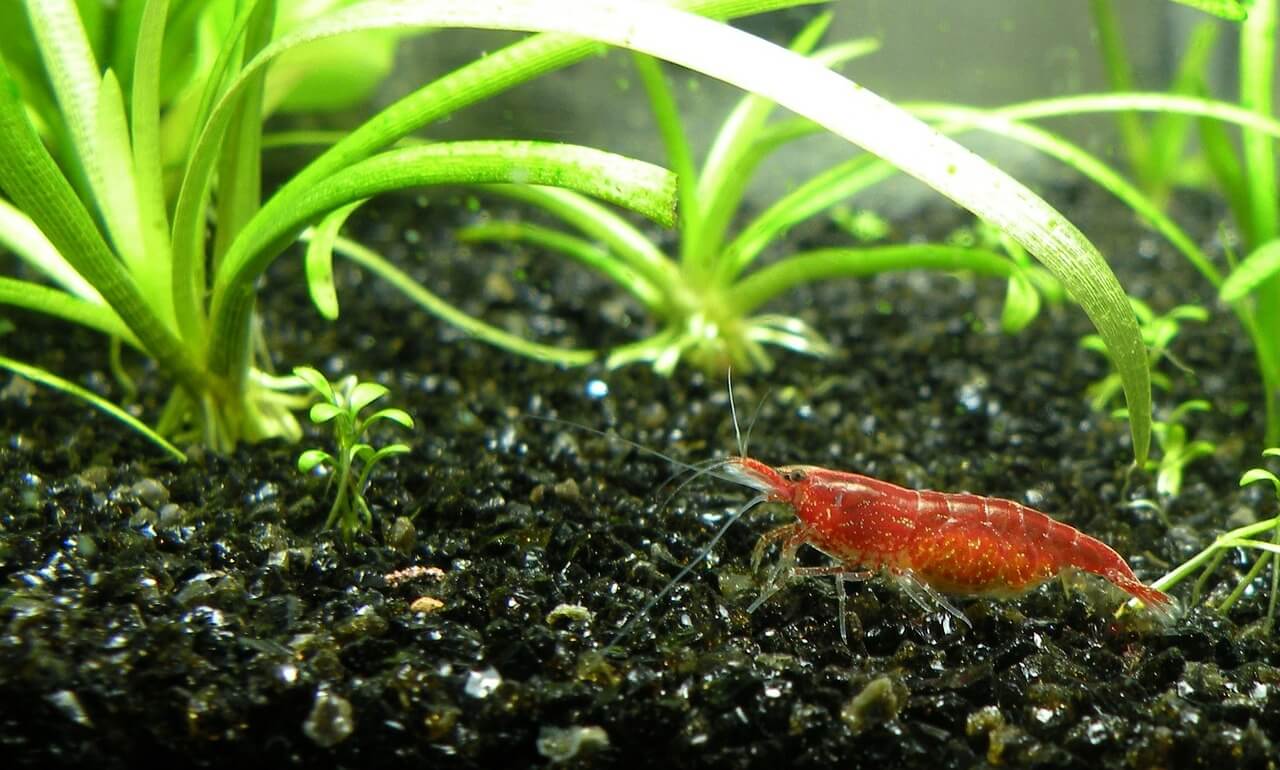One of the most common freshwater shrimps is the Cherry Shrimp. Whether you are a new or experienced aquarium owner, it’s always a good idea to add some invertebrates to your tank. What makes them beginner-friendly is that they are easy to keep.
These shrimps flaunt beautiful and vibrant red colors that will brighten up your tank. If you are planning to buy some Cherry Shrimps, here are some things you should know.
We will look at their appearance, behavior, dietary requirements, tank conditions, tankmates, and breeding. Hopefully, this guide can help you decide if the Cherry Shrimp is right for you.
| Category | Rating |
| Scientific Name: | Neocaridina davidi |
| Common Names: | Cherry shrimp, red cherry shrimp, fire shrimp |
| Care Level: | Easy (Beginner Friendly) |
| Temperament: | Peaceful |
| Size: | Up to 1.5 inches |
| Color: | Red |
| Life Expectancy: | Up to 2 years |
| Diet: | Omnivore |
| Family: | Atyidae |
| Tank Size: | Minimum 5 Gallons |
| Tank Setup: | Planted and rocky aquarium |
Table of Contents
Overview

It has classified as Neocaridina heteropoda and is sometimes known as Red Cherry Shrimp. They are a dwarf freshwater shrimp from Taiwan that is part of the Atyidae family. In general, Cherry Shrimps are peaceful and known to be an effective alga eater.
Their bright appearance will enhance any tank while needing very little maintenance. In general, you can expect the shrimp to live up to two years.
Being hardy and easy to keep, this species is suitable even for beginners. While they can adapt to a wide range of setups, they prefer tanks that are heavily vegetated with plenty of hiding places.
In the wild, you can find these shrimps in a range of colors, but the commercially bred aquarium species mostly come in red. What’s even more interesting is that they are now graded based on the shade of red, though we will discuss this in-depth later.
Behavior
Like a lot of other invertebrate species, the Cherry Shrimp is not aggressive and extremely peaceful. They tend to be quite active most of the time, both day and night.
You can watch these shrimps in their activities and will usually find them grazing on various parts of the aquarium. This could be the plants, moss, algae, or substrate.
Appearance
One of the most appealing or defining characteristics of this species is their red color, which is graded. The grading system goes from the deepest red color to paler shades with only occasional red spots.
The most common and lowest grade is regular cherry shrimps, which are clear-colored and have red spots. The next step is the Sakura Cherry Shrimp. They have more red colors but still maintain a few clear spots.
If you are looking for a full-red look, then go for the Fire Red Shrimp. Meanwhile, the most expensive of this species would be the Painted Fire Red Shrimp. They flaunt a beautiful, deep shade of red with zero clear areas. Even their legs are usually red!
In terms of size, female Cherry Shrimp can measure up to 1.5 inches in length. They are also usually more colorful. Meanwhile, their male counterparts tend to be a little bit shorter and have a paler countenance.
It is impossible to tell the males and females apart when they are juveniles. However, the female shrimps will develop a sort of saddle as they mature. This will be where the eggs are held before they are fertilized.
Cherry Shrimp Care Guide

While they are an overall agreeable species which do not require particular care, there is one thing you should know. These shrimps are also known to shed their exoskeleton but do not remove them from the tank. They will feed on it to replenish their mineral content.
The Cherry Shrimp is very sensitive to copper! This element is present in a lot of fish foods, so make sure to double-check. Likewise, they do not do well with ammonia spikes. Please make sure that the water conditions are as stable as they can be.
Tank Setup & Habitat Preparation
As we have mentioned earlier on, Cherry Shrimps are native to Taiwan. They can be found in the wilderness along streams and ponds with lots of plants and rocky substrates. To keep your shrimp happy, we recommend trying to recreate this natural habitat in your aquarium.
The most important thing is to provide a lot of vegetation as this would allow them to thrive. Dense plants will also give them enough hiding nooks. You can also add driftwood that may develop algae overtime and the shrimp can nibble on these.
Your aquarium would also need some moss where the Cherry Shrimp can hide in. We personally like adding Java Moss. When they feel safe, their coloration will be enhanced and appear brighter. A good thing for your tank’s visual aesthetics! The substrate can contain tiny pebbles to simulate the rocky substrate of their natural habitat.
What about filters? You can use one as long as it’s not too powerful that it will suck in the shrimp. Using a sponge filter will also avoid this problem. Otherwise, try placing an air stone to keep the water oxygenated too.
Water Parameters
Moving on to the tank conditions that will allow Cherry Shrimp to live healthily. In general, the lower grade shrimps can survive in poor water conditions, while higher grade ones require better conditions.
You should aim for a temperature of 65 to 85°F, and pH level of 6.5 to 8.0. Oh, it’s also crucial that you do not put these shrimps in an uncycled tank. They are quite sensitive to the presence of nitrites in the water.
Recommended Tank Size
The great thing about this species, and most other invertebrate species for that matter, is that you do not need huge tanks. Even 5 gallons would be enough for a few Cherry Shrimps. Of course, you have to adjust the water volume as you add more of them.
Try to only keep around 2-5 shrimps per gallon of water to make sure that there are enough space and hiding spots for each of them. You might also want to note that this species is known to breed rather quickly. Therefore, it can be a good idea to provide a bigger tank.
Feeding Your Cherry Shrimp

Because they are natural scavengers, these omnivores will eat anything you feed them, whether that’s meat or plant. This also means feeding these shrimps is an easy job!
Try to stick to good quality pellets as the main diet, which you can supplement with other things. Vegetables are allowed but should first be blanched. From spinach and lettuce to carrots and cucumber, these would be excellent options for your Chery Shrimp.
This species is also notorious for being a great algae eater. They may not be able to clean the entirety of your tank (remember, they are quite tiny!). Still, they can play a part and keep the underwater home at least a little cleaner.
It’s also important that you do not overfeed them, especially because they don’t generally eat that much. Remove any excess food to avoid water pollution and keep the tank healthy for its inhabitants!
Cherry Shrimp Tank Mates
On the one hand, the peaceful nature of Cherry Shrimps makes them the perfect addition to most community tanks as they will not initiate attacks on other species. On the other, they have no way to defend against aggressive fish.
Even if there might be occasional incidents and the shrimp get eaten, they do reproduce quickly. This will help nourish the shrimp population. You should pay attention to who you choose as their tankmates!
If not, you may risk placing the shrimps only as food for the predatory species. While you can put lower-grade shrimps with other tankmates, it is recommended to keep their higher-grade compatriots in a single species tank.
Some of the best tankmates for your Cherry Shrimp are mostly freshwater snails, catfish, Dwarf Gouramis, and small Tetras. Try to avoid fishes such as Arowanas, Cichlids, and Oscars. Whichever you end up placing the shrimps with, make sure there are plenty of hiding spots to provide more security for them.
Can You Keep Multiple Cherry Shrimps Together?
While some freshwater species thrive well on their own, the Cherry Shrimp is far from being a solitary creature. In fact, they cannot survive on their own. It is even best to keep them in a species-only tank.
In a community tank, you should keep a minimum of 10 shrimps together. This will avoid dominance while boosting group confidence, which then allows their natural behavior to shine. The male to female ratio should not be a problem as they breed easily. However, we would say having more females than males are advisable.
You can even add other shrimps in the aquarium to create more biodiversity. This includes the Ghost Shrimp and Amano Shrimp. Both can be suitable tankmates for Cherry Shrimps.
Breeding Cherry Shrimps
Another reason that makes the Cherry Shrimp so likeable among hobbyists is the fact that they breed easily. If your shrimps are healthy and well, the breeding process is extremely simple and straightforward.
Before breeding, you have to ensure that the tank is in ideal condition. Having lots of plants will give a sense of comfort and safety. You should also feed them foods that are high in protein content.
The final step is to make the temperature 82°F, which recreates the beginning of the summer. This is the season when Cherry Shrimps in the wild are known to breed most effectively.
They are considered sexually mature at around 4 to 6 months old and can start breeding if they are adapted to their new aquarium environment. In general, this will take at least 3 months or 5 months at the most.
It is easy to spot when a shrimp has mated as the females will carry eggs under the tail. She will sometimes fan her tail to oxygenate the eggs, which will hatch in around a month. In terms of appearance, baby shrimps are pretty much the tiny version of the adult ones
Don’t worry if you see the parents leaving the little shrimps to fend for themselves. Like other fishes, Cherry Shrimps are used to care for themselves even since birth.
There is also no need to separate them into a new aquarium. In fact, these baby shrimps can only survive in a matured tank. An uncycled one will not provide the necessary organisms for them to feed on and grow.
Should You Get Cherry Shrimp for your Freshwater Aquarium? (Recap)
Finally, the question remains about whether you should get Cherry Shrimp. We hope this has been useful in telling you the most important information about this easy-to-care shrimp species.
They are indeed fantastic shrimp that can enhance your freshwater aquarium. It is an easy way to keep things interesting and lively, thanks to their vibrant red coloring. Not only that, their hardy and adaptable nature make them great choices for beginners.
You don’t have to care for them too much. In the right tank and with the right company, these shrimps will thrive on their own!






